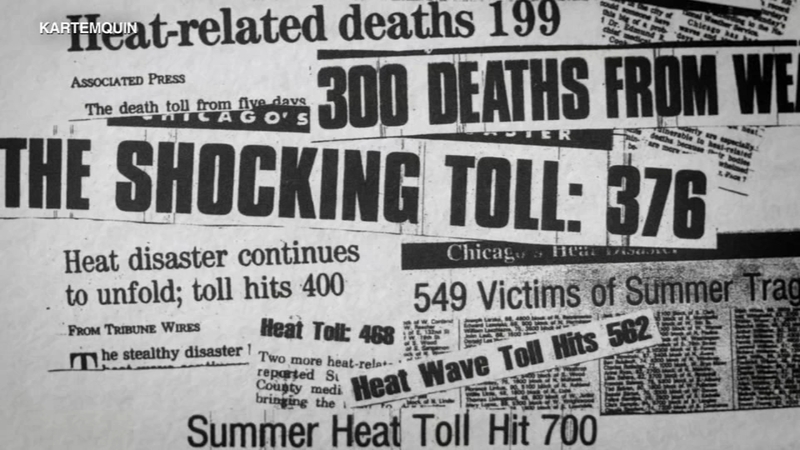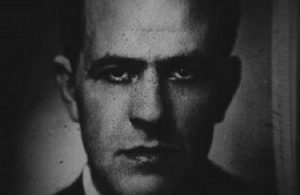It was Wednesday July 12, 1995. The time was 3:30 pm. The daily heat advisories were given out by the National Weather Service office in Romeoville but they were nothing out of the ordinary. With the temperature being 97 degrees and no serious call to action statement from authorities, life in Chicago went on as usual. At Comiskey Park, the Chicago White Sox’s were set to play the Milwaukee Brewers. Across the city, Mayor Richard M. Daley was speaking at a ribbon-cutting ceremony for the grand reopening of Navy Pier. But as time ticked on, the grounds of Chicago would become a giant blast furnace with the lives of 739 people falling to this wrath.1
Thursday July 13. Temperatures have now hit 104 to 106 and those on the streets were reported to be “walking in a daze.” Weather authorities have been well aware of the heat but have written it off simply because the summers in Chicago are usually very hot. The forecast was monitored but not seen as an immediate threat, so therefore no one really changed what they did. Lake Michigan and community pools were packed with crowds and there were over 3,000 fire hydrants that had been illegally opened trying to combat the heat. Despite these efforts, people have begun to suffer from heat-related problems and were growing concern for their loved ones. 911 operators were being flooded with a staggering 16,727 number of calls complaining about the heat. While paramedics were being called all over the city, emergency departments and waiting rooms were filling up rapidly, causing workers to operate like a pit crew in Nascar. As they began to enter “crisis mode,” panic was on the verge of ensuing, the authorities were still not taking it too seriously.2
Friday July 14. As the heat spreads, City Hall officials were again not aware of the disaster that was about to unfold. Emergency rooms were beginning to deny new patients as across the city over 49,000 residents have lost power, deeming air conditioning and other methods of cooling off useless. Mayor Daley’s attitude now was very nonchalant towards the heat, because extreme weather is common in Chicago; however, numerous bodies were dropping in districts that were isolated from the main center of the city. The Daley administration was completely neglecting the lower income neighborhoods as people were dying in large numbers. Neighbors were calling authorities to come check in on the elderly because there was no one going to check on them and give them the help they could not get for themselves. Because many victims were not getting the attention they deserve from the Daley administration, their bodies were laying dead in their own homes and no one even knew it. As the day ended, the city’s medical examiner’s office had over forty cases for the next day alone, which never had that many cases for one day in their history.3

Saturday July 15. The Last Day. Temperatures now were near triple digits and the humidity was steadily high. Deputy Chief of Staff Sarah Pang received a call demanding an emergency City Hall meeting to figure out what was going on and what plans needed to be taken. However, there was no plan because no one in that department understood how dangerous heat was or could be. They were used to snow and how dangerous extreme cold could be but they had never seen a disaster like this one ever, so they did not know what to do or who to rely on. Many politicians, chiefs in offices, and other authorities within the city were not fully aware of the number of bodies or the transportation methods being taken because everyone and everything was scurrying all at once. While the mayor was vacationing in Grand Beach, Michigan, health department officials had declared a citywide heat emergency with all 56 ambulances and 600 paramedics being called to service. Trucks, refrigerators filled with decomposing bodies, and medical professionals were all scattered around the city in pandemonium. At the Cook County morgue, the scene can be described as a “cavalcade of police vehicles and ambulances delivering one corpse after another.” Reporters were criticizing the city’s delay in calling for an emergency. Citizens had wondered why the plan for cooling centers and public advisors wasn’t enacted earlier. Morgue volunteers were trying to get over the psychological effects of seeing massive piles of dead bodies all day. The police were frustrated with getting loved ones to check in on their own family members and report any problems. It seemed like every department had a different yet equally difficult task to handle. By the end of the day, the death toll had reached 269.4

Sunday July 16. The situation remained dire as calls continued to pour in as more bodies were discovered. The task of counting the number of casualties was difficult as more bodies were being discovered and accounted for by the hours. This cycle of counting and autopsies would continue on through October of that year. Those findings would ultimately conclude that 739 people died during the July heat wave. While this was happening, Mayor Daley had gathered his staff at City Hall to deal with the escalating crisis and intensifying media scrutiny. Reporters questioned why the city waited two full days to declare an emergency, why cooling centers weren’t employed sooner, and why the police weren’t asked to check on seniors sooner.5

Many lessons were learned and many questions were left unanswered. But, the biggest question that was still to be answered was what could they have done to prevent the deaths of over 700 people? Sociologist Eric Kilnenberg, who lived to witness the heat wave, years later offered a different way to combat such a disaster. As today we are all practicing “social distancing,” Kilnenberg believed that the practice of physical distancing rather than social distancing was the correct way to go. An example today could be to standing six feet apart from someone (physical distance) but still be able to be in their presence and maintain social interaction. Most of the victims were elderly people who did not have air conditioning and/or did not have any access to help. As a result, they died alone simply because they were socially distant from everything and everyone. Everyone still had their neighbors but everyone was so socially disconnected that the physical space did not matter or offer any help. It is like when a hurricane occurs, volunteers and organizations are out helping others and assisting in any way possible, but in 1995, Chicagoans had the “every person for themselves” mentality. They “socially distanced” from everyone else because they were only concerned for themselves. Even when people decided to socially reach out to others, they were already dead. Klinenberg offered the idea of having just a physical distance while maintaining a social connection with those who are vulnerable so that you could keep tabs on them. It is the willingness to check on someone’s health and well being while being physically distanced by a house down the street or even a room in your house, which can sometimes be the difference between life and death.6
To bring it to today’s pandemic reality, it can be the same as following the social mandates such as wearing a mask when out in public and staying six feet apart even if you aren’t sick. That act alone protects those who are vulnerable and gives them a chance to stay healthy. Another one is not hoarding up on necessities when there are those less fortunate who will need them more than you. For Klinenberg, the concept is simple: physically distant yourself, maintain social connection with others, and be courteous to those who are vulnerable because these acts can be the difference between saving lives or adding to a seemingly never-ending dilemma.
- Mike Thomas, “Chicago’s Deadly 1995 Heat Wave: An Oral History,” Chicago Magazine, July 2015. ↵
- Bonnie Miller Rubin and Jeremy Gorner, “Fatal Heat wave 20 years ago changed Chicago’s emergency response,” Chicago Tribune (Chicago, IL), July 15, 2015. ↵
- Mike Thomas, “Chicago’s Deadly 1995 Heat Wave: An Oral History,” Chicago Magazine, July 2015. ↵
- Mike Thomas, “Chicago’s Deadly 1995 Heat Wave: An Oral History,” Chicago Magazine, July 2015. ↵
- Mike Thomas, “Chicago’s Deadly 1995 Heat Wave: An Oral History,” Chicago Magazine, July 2015. ↵
- Eric Kilnenberg, “Denaturalizing Disaster: A Social Autopsy of the 1995 Chicago Heat Wave,” Theory and Society 28, no. 2 (1999): 239-95. ↵



23 comments
Alicia Martinez
It is interesting to read that social distancing seems like a possible strategy to combat an intense heat wave in Chicago. However, I am not entirely sure that physically distancing from each other during an extreme heat wave is the best solution to ensuring the health and safety of people. This event seems similar to the recent winter storm that left Texans without power and facing very cold temperatures that we were not accustomed to. The problem that is now looked into is how Texas powerlines were not able to remain functioning, whereas cities like El Paso did not experience many problems. I think for Chicago to ensure the safety of their people, they’re administration needs to examine how they’re power grid can be sustainable during extreme temperatures and to inform they’re people on how to best prepare for such disasters.
Danielle Litman
This article really hit home for me. I grew up near Chicago, and my father grew up there so I had family there and was always visiting. I realized how the Chicago heatwave was also very similar to the snow/ice storm in Texas 2012. Both states were not prepared for the extreme weather conditions and we saw from both situations the most affected were the lower class. Highlighting that the lower class is always neglected. Additionally, in these situations the proper authorities were not prepared.
Evangelina Villegas
This was an interesting article to read as I had never heard about the 1995 heat wave in Chicago before now. I liked how it was separated by days to really show how much had happened within a few days. The heat wave and the severity of it reminds me so much of the winter storm from the drastic climate change to the natural disaster response. It really is sad to read on how so many people had tragically lost their lives.
Maria Moreno
Reading this made me remember my hometown in Arizona. Where each year the highest temperature would vary from 116-119 degrees. I remember going to the store and as I came out to the parking lot feeling a heat wave that made me feel I was entering an oven. Once, the Air conditioners weren’t working at my school and many called their parents to be picked up and my teacher told us about a time close to this heat wave in Chicago in 1994 where the temperature was 128! So I understand how people could have gone a little crazy if they aren’t used to the heat, I can’t imagine them visiting Arizona for the weekend during the summer.
Faith Chapman
As someone else pointed out, I also like how the article was separated into days; it almost feels like you’re experiencing the passing of time as the heat grows worse and worse. For me, living in one of those states that’s supposed to be hot in general, and very hot in the summer, I can understand why no one thought anything was amiss initially, especially since this heat wave occurred during the summer. Although, I am a bit concerned that I’ve never heard of this incident before despite living in a state known for being hot, and I only read this by chance.
Camryn Blackmon
Hi Tavion,
It is crazy that I had never heard of this heatwave until I read your article. This is such a big event, and many died. I feel like this is also an instance of climate change and natural disaster response that could have been used for cities to learn from years later. Still, sadly enough, cities in Texas just experienced a similar event with the snowstorm. So many people had died or suffered from the snowstorm, but reading your article, I feel like local city government and state governments could have used this event to learn from it. Sadly, this occurrence is not taught or well known, but I am glad you brought awareness and related it to the pandemic.
Nathaniel Tran
I really liked how this article put a real meaning on social distancing and even connected it to our current pandemic and situation. It is sad to hear that so many avoidable deaths happened back then due to the heatwave. It actually scared me how badly a heatwave was and how many deaths it caused. Hopefully, more people read this article and see the message.
Victor Rodriguez
It is my first time hearing about the heat wave of 1995. I thought it was very captivating to read about this topic, especially nowadays that we are experiencing more heat waves than usual due to global warming. The temperature that we have recorded lately has broken many record numbers. Global warming is real and we must be prepared for major heat waves that come our ways. Global warming affects everyone, but like mentioned in the article, it primarily affects people with low income and minority groups. These people are at a disadvantage because they do not have access to resources to protect themselves from the major disasters and harm global warming is causing.
Chloe Martinez
This article was great in correlating the heat wave incident that occurred in 1995 in Chicago to the on-going pandemic, COVID-19. I liked how the article was structured to have the events on the specific dates as if it was a timeline. This article was great in focusing on the difference between social-distancing and physically-distancing.
Kayla Sultemeier
I have never heard of the 1995 heat wave of Chicago. It is sad to imagine that so many elderly people and low income families could have lost their lives to something so difficult. It seems like this nation has a very hard time handling and dealing with priority issues that leave their lower income residents in shambles, so sad.